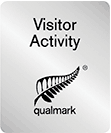Design solution reduces cost, time and impact on heritage features
Thursday, 7 July 2022
An extensive phase of geotechnical and structural investigation of Rotorua Museum Te Whare Taonga o Te Arawa has concluded, delivering a new design solution that reduces the impact on heritage features while also being faster and less expensive to build.
Following a design review, specialist structural engineering consultants Dizhur Consulting and geotechnical consultants Tonkin & Taylor
were brought on to the project in April 2021. Since then they have carried out comprehensive testing and analysis of both ground and building, in collaboration with external laboratories and the University of Canterbury, to develop a structural design solution that takes into account the unique and complex ground characteristics and building composition.
Geotechnical Engineer Mike Jacka, from Tonkin & Taylor, has worked on a wide range of detailed structural strengthening projects around New Zealand and explains there is one extra element that makes the Rotorua Museum project that much more complex.
“One thing here {Rotorua} which is more complicated and that is these ground conditions. Most other projects are on pretty conventional ground but here we have the geothermal issue. That gives us problems both in terms of getting testing done safely, analysis techniques used in the rest of the country fall short here on strange soil and issues for construction. All that, along with a complex building, makes this a complex site. That is why we are here and this is what we specialise in”, says Mr Jacka.
This investigation determined the ground strength is 70% New Building Standard (NBS), which is not considered earthquake prone and exceeds both the regulatory requirement to achieve 34% or higher, and the New Zealand Society of Seismic Engineers recommended minimum of 67%.
In an update to elected members in April this year, Council resolved to accept the 70% NBS ground strength, instead of the target 80% NBS, on the basis that the cost benefit (saving an estimated $15m) and risk assessment did not support the additional works required to achieve 80%.
Since April, discussions with external funders have secured their continued commitment based on the new ground strength of 70% NBS. External funders account for 71% ($38m) of the build funding and Rotorua Lakes Council’s contribution is 29% ($15.5m).
The structural design concept for the building utilizes a displacement-based philosophy which strengthens the existing building fabric, rather than an earlier direction which essentially meant building a new structure and tying the building to it.
“We want to utilise as much of the building fabric as much as we can”, explains Dr Dmytro Dizhur, Structural Engineer (Dizhur Consulting).
Despite the more cost effective structural design, the costs of the Rotorua Museum project are estimated to exceed the current project budget by $18-20m. This is primarily due to the impacts of COVID (estimated at an additional $11m) and the move to hold a higher contingency in line with Treasury New Zealand recommendations ($7m increase from $8m – $15m total contingency). In addition, some targeted groundworks under the atrium gable walls are required to address ongoing settlement estimated between $3-$5m.
Talks are now underway to obtain the additional funding required to finish the project. The project team has also identified a possible staged approach if the additional funding is not secured.
The staged option would include:
• Full structural strengthening of
the building to 80% NBS (noting the ground remains at 70% NBS)
• Full roof replacement
• Fit out and services for zones
1-3, including the central atrium and South Wing (Te Arawa galleries and
temporary exhibition space upstairs).
The remaining fit out could be completed once the required additional funding was secured.
As discussions with funders continue, work will continue on detailed design, building consenting and tender pricing. A comprehensive package of information will be presented to the new Council with greater clarity on the required budget and any additional funding.
The Rotorua Museum project team will be hosting public sessions over the next two months to give further details around the process so far and what the next steps are.











